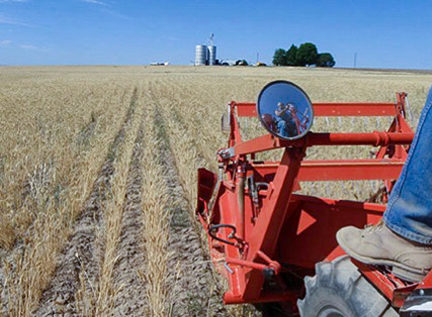LIND, Wash. — In the world’s driest rain-fed wheat region, Washington State University researchers have identified summerfallow management practices that can make all the difference for farmers, water and soil conservation, and air quality.
Wheat growers in the Horse Heaven Hills of south-central Washington farm with an average of 6-8 inches of rain a year. Wind erosion has caused blowing dust that exceeded federal air quality standards 20 times in the past 10 years.
“Some of these events caused complete brown outs, zero visibility, closed freeways,” said WSU research agronomist Bill Schillinger.

|
| ON TRIAL. Harvesting hard red winter wheat at the western trial site in 2008 yielded 16 bushels per acre. (Photo by Washington State University) |
Science to Anchor Farmer Incentives
He and WSU agricultural economist Doug Young compared three fallow management systems in the western part of the Horse Heaven Hills with six inches of annual rainfall and the same practices in the eastern part with eight inches of rain.
The study was published in the Soil Science Society of America journal in September: Schillinger, W. F. and D. L. Young. (2014). Best Management Practices for Summerfallow in the World’s Driest Rainfed Wheat Region. Soil Science Society of America Journal. 78:1707-1715 doi: 10.2136/sssaj2014.04.0168.

|
| MIXED METHOD. Alternating strips of undercutter tillage fallow and traditional tillage fallow in the eastern Horse Heaven Hills in 2009. (Photo by Washington State University) |
The five-year study provides the U.S. Department of Agriculture’s Natural Resources Conservation Service with science-based information needed to develop incentives for wheat farmers to change from traditional-tillage fallow practices to undercutter-tillage or no-till fallow systems.
Farmers in the Horse Heaven Hills practice a winter wheat-summerfallow rotation where only one crop is grown every other year on a given piece of land.
Average yields can be as low as 18 bushels per acre – compared to upwards of 120 bushels per acre in the higher rainfall area of the Palouse in eastern Washington. Though the margins are tight, with careful management wheat farming in the Horse Heaven Hills can be profitable.
To get the highest yield, farmers need to plant winter wheat in late August or early September after a year of fallow. The fallow period allows enough moisture from winter and spring rains to accumulate in the soil for seeds to get established.
“In east-central Washington, if you can’t plant in late summer into deep seed-zone moisture in fallow, then you have to wait for fall rains in mid-October or later,” Schillinger said.
The longer it takes to get winter wheat seedlings established, the lower the potential for good yields.
To help ensure precious soil moisture remains in the seeding zone, farmers till the soil in the spring. Tillage breaks up the capillary action of the soil; this helps slow soil moisture evaporation in the seed zone during the hot, dry summer months.
But too much tillage can cause soil loss through wind erosion that feeds hazardous dust storms.
Undercutting in the East
Compared to traditional tillage, Schillinger and Young found that undercutter tillage was the best option for fallow in the slightly moister eastern region of the Horse Heaven Hills, where late-August planting is possible and spring tillage helps retain summer soil moisture.
With wide, narrow-pitched, V-shaped blades, the undercutter slices beneath the soil surface to interrupt capillary action in the seed zone without causing much disturbance of the soil surface.

|
| GETTING UNDER. An undercutter with V-shaped blades used for primary spring tillage with fertilizer injection during the fallow year. (Photo from Washington Association of Wheat Growers) |
Schillinger said scientists and farmers have conclusively shown that spring tillage with the undercutter effectively retains seed-zone moisture. It also retains significantly greater surface residue and surface soil clods – which are less likely to be disturbed by wind and become airborne – compared to traditional tillage implements such as a tandem disk or field cultivator.
No till in the West
In the western region of the Horse Heaven Hills, the best option for controlling wind erosion was to practice no-till fallow; that is, to avoid tillage altogether. Most of the time, rainfall in this area simply isn’t sufficient to establish an early stand of winter wheat with any fallow management system.
“There’s no reason to till the soil when you already know in the spring that it will be too dry to plant wheat in late August,” Schillinger said.
Economist Young found that, despite the modest grain yield potential, wheat farming in this environment can be profitable — with enough acreage and judicious use of inputs to manage costs. In fact, late-planted winter wheat on no-till fallow was just as profitable as traditional-tillage and undercutter-tillage fallow treatments at the western site.






